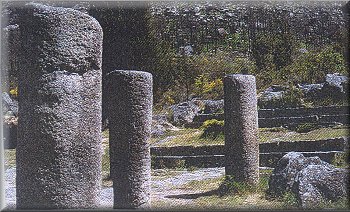
ROMAN ROADS IN GALICIA
There are two kinds: raedae (opened roads) and carruiae (closed roads). There are three important roads: the 18, the 19 and the 20, and they link different places. These roads have mistakes in the mileage. They take to diverse roads and, many times, the same road could have different names.

A lot of roads are, or were, covered with marble and they were frequently used by merchants. They brought more speed in battles and conquests, especially because there are a lot of secondary roads. They are folklore's sources as they improve communication amongst "villas". They helped plan the troop movement previously mentioned and they made the nucleus of population grow up. They made the traffic of the cursus publicus or post easier, that one could also be cursus velox, for emergency missions.
The Roman roads best kept are around Chaves, the old Aquae Flaviae in the north of Portugal, very close to the Spanish border. Some roads have important cavities in their layer. Others are covered by soil, in ruins, abandoned, tortuous...
Some roads are used also for touristic purposes or to serve as water channels. Although almost all are abandoned, the stones can be used for other purposes.
In general, all the route from Bracara to Asturias is marked with a lot of milestones, sometimes concentrated in certain dots which usually match up with the location of old milestones.
SITUATION OF MILESTONES IN GALACIA
Milestones are cylindrical pillars made of granite, with standard measurements and a cubic or square-shaped base. They were situated along the roads to point out the miles. They are equivalent to the marks used nowadays. They measured the distances between the points where they were situated and the arrival or departure point. Milestone inscriptions were engraved directly on the stone. Their height varies between 0.6 and 2.6 metres, and their diameter between 0.65 and 3.25 metres.
At the beginning, the inscription on the milestones was very simple: the mile and the names of the Emperor and of the Consol related to the time when the road was built were shown on it.
The milesones that we can see in the North are very high with a perfectly cylindrical perimeter. The ones shown in the photograph are a good example of their shape.
Milestones
Most milestones are concentrated along the new road, mainly on the Spanish side of Portela do Home.


